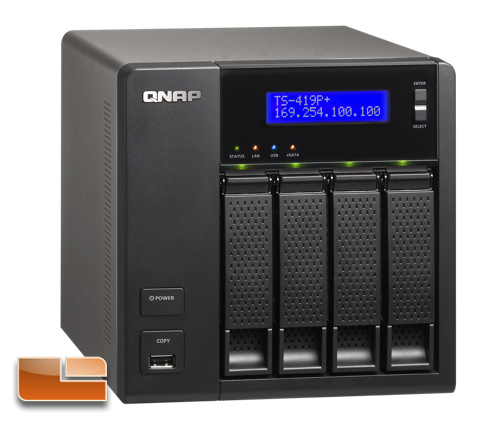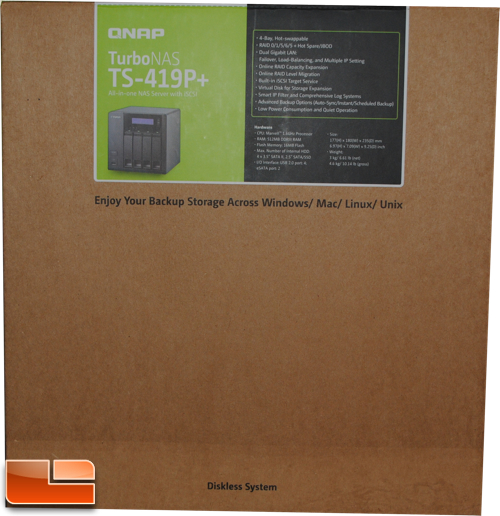QNAP TS-419P+ Turbo NAS 4-Bay Network Storage Review
Introducing the QNAP TS-419P+ Turbo NAS
About six months ago, I started looking into building a Home Theater PC Solution that fit my needs. Seeing I already owned an Xbox 360, and not wanting to build a separate PC, I decided my best route was to look at some type of device that could stream to an Xbox 360 using UPnP. I ran into many roadblocks, some devices did not support a large storage pool, and others were just too expensive. When asked to review the QNAP TS-419P+, I was thrilled to see that the device supported just the type of streaming that I wanted.

Like most people, I have a rather large DVD Collection, and the collection takes up a lot of room. I wanted to be able to store my DVDs in a digital format, and be able to access them at any time. I also wanted to know that my files would be safe in the event of a drive failure. I wanted a NAS that had advanced RAID capabilities, used relatively little power, and as noted before, could stream to a variety of devices. After reading that the QNAP TS-419P+ had Raid 0, 1, 5,6, single and JBOD Disk Configurations, online RAID capacity expansions, a built in UPnP Media Server, a 1.6GHz CPU and 512MB of dedicated ram, I felt that the NAS would be a good candidate for my needs.

|
Software Specifications:
|
Operating System |
Linux-embedded system |
|
Networking |
TCP/IP, DHCP Client, DHCP Server, CIFS/SMB, AFP, NFS, HTTP, HTTPS, FTP, DDNS, NTP |
|
Multi-IP setting |
|
|
Gigabit Jumbo Frame |
|
|
Port Trunking |
|
|
Network Service Discovery (UPnP & Bonjour) |
|
|
File System |
EXT3 (Internal/ external HDD) |
|
EXT4 (Internal/ external HDD) |
|
|
FAT (External HDD) |
|
|
NTFS (External HDD), HFS+ |
|
|
Supported Operating Systems |
Microsoft Windows 98/ ME/ NT/ 2000/ XP/ 2003/ Vista/ Windows 7 (32bit & 64bit) /Server 2003/2008 |
|
Mac OS X |
|
|
Disk Management |
Sngle disk, RAID 0 (Disk Striping), RAID 1 (Disk Mirroring), RAID 5, RAID 5+ Hot spare, RAID 6, and JBOD (Linear Disk Volume) |
|
Multiple RAID |
|
|
Disk usage status management |
|
|
Check disk (Check Linux file system) |
|
|
HDD S.M.A.R.T. |
|
|
Bad blocks scan |
|
|
Built-in iSCSI target service |
|
|
Virtual Disk Drive (VDD) for storage expansion (max. 8 Volumes) |
|
|
User Management |
User quota management (per user) |
|
Windows AD |
|
|
User account management (max. 4,096 users) |
|
|
User group management (max. 512 groups) |
|
|
Batch creating users |
|
|
File System Management |
Network share management (max. 512 shares) |
|
Network volume status management |
|
|
Share folder level ACL support |
|
|
Hide share folder on Windows network |
|
|
Unicode support |
|
|
Journaling file system |
|
|
Web File Manager |
|
|
System Tools |
E-mail alert (SMTP authentication) |
|
SMS alert |
|
|
HDD standby mode |
|
|
Disk usage alert |
|
|
Automatic power on after power loss |
|
|
System firmware upgrade |
|
|
Back up, restore, reset system settings |
|
|
Smart fan setting |
|
|
Configurable management port |
|
|
Policy-based unauthorized IP blocking |
|
|
Secure remote login by SSH connection |
|
|
Remote login by Telnet connection |
|
|
USB, SNMP UPS support |
|
|
Schedule power on/ off (max. 15 settings) |
|
|
Network recycle bin |
|
|
Import SSL certificate |
|
|
Real-time System Resource Monitor |
|
|
LCD |
When the system is ready, users can check or configure the IP settings, physical disk info, volume info, system info, shut down or reboot the NAS, etc. |
|
Event Logs |
Complete system logs (file level): system events management, connection logs, current connection of on-line users |
|
Multilingual Support |
English, Traditional Chinese, Simplified Chinese, Japanese, Korean, French, German, Italian, Spanish, Russian, Swedish, Norwegian, Finnish, Danish, and Polish |
| Applications | File Server, FTP Server, Backup Server, Web Server, Media Server, Download Station, Printer Server, Surveillance Station, QPKG |
|
Backup Management |
PC-client backup software-NetBak Replicator: Instant/ Schedule/ Auto-sync backup |
|
Remote replication supports Rsync |
|
|
Encrypted remote replication |
|
|
One touch USB copy for different destination folders |
|
|
Data backup to external storage device |
|
|
Multi-browser support |
Internet Explorer 7 & 8 |
|
Safari 3 & 4 |
|
|
Firefox 3 |
|
|
Google Chrome |

Comments are closed.